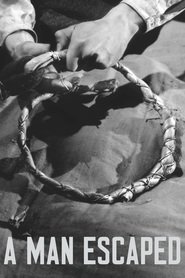 In the immediate aftermath of the destruction of World War 2, the French searched far and wide for examples of their resistance to show the world that they were not the Nazi appeasers that they actually were.
In the immediate aftermath of the destruction of World War 2, the French searched far and wide for examples of their resistance to show the world that they were not the Nazi appeasers that they actually were.
There was however a brave minority of French citizens who actively resisted the evil German occupation. One of those people was the great director Robert Bresson and his experience during that dangerous time was one of the driving forces of his creativity. “A Man Escaped”, is a true account of Resistance fighter Andre Devigny and his escape from the infamous Montluc prison in occupied France, that happened on the same day he was to be executed.
What Bresson created is one of the best and most suspenseful prison escape films ever made. That he did this in his unique neo-realistic style makes it all the more powerful. Bresson took Hitchcock’s visual artistry in which the visual supersedes any dialogue up a few steps as his film is very sparse in conversations and rich in suspense.
He used non-actors and their performances are based on glance and expressions through Bresson’s unique views coming out as being both real and intense.
The film itself uses fictional names and characters to tell its tale of Devigny’s escape. This was a smart move as it allows Bresson to take liberties with some of the co-prisoners that allow us to dig deep into the sense of what it may have been like to be incarcerated in such a facility of death.
Francois Leterrier plays the Devigny character named Fontain and most of the movie deals in his time and space spent in his small stone cell. We follow his viewpoint throughout the movie and mostly in silence. Slowly, we, along with Fontain search and discover a way of escape.
While watching the movie I felt the claustrophobic effects of internment, as our view follows those of Fontain’s. As soon as the act of preparing for the escape begins, Bresson ratchets up the tension by use of small sounds such as footsteps and scratches in the walls. These sounds replace an actual music soundtrack for most of the movie. Combining these sounds with cutting shot views of all the dangers lurking in the small prison, leaves the viewer on the edge of their seat. Bresson attains this feel by following our protagonist with long or medium shots that show him as a whole and follow his actions with the same speed as it occurs, which is slow. There are no shock effects here. There are only slow and determined suspense.
We are not shown the guards as full characters and only see them through quick glimpses. Executions are carried out off screen resulting in a deep sense of fear and horror.
Near the end of the movie Bresson adds an additional character to Fontain’s cell, allowing additional suspense as we and Fontain are never sure about the new person’s true intentions.
The escape itself is tense and rewarding. Watching this film about courage and perseverance is a rewarding experience and served as the inspiration of countless prison escape films ever since.

